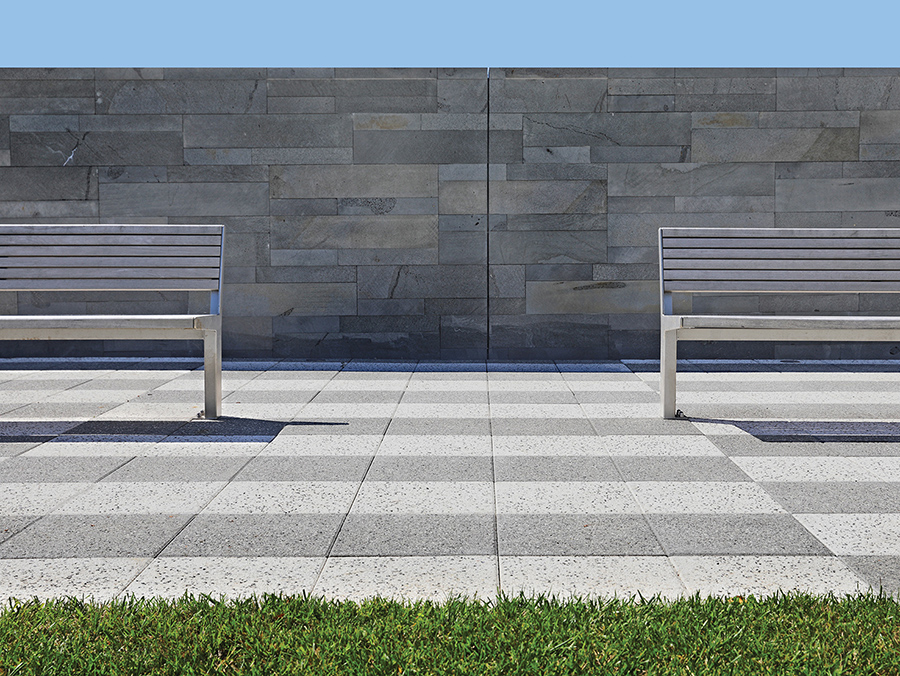
Paving large areas for commercial or residential use can require a large investment. To protect your investment it helps to understand the performance of your paver and the role the pavement option you choose - either flexible or rigid - has in the overall performance, durability and maintenance of your paving.
With the large quantities of natural stone being supplied and laid on a concrete base, it could be assumed that all paving should be laid this way. Not so. The beauty of concrete paving is that it has been designed to be laid on a flexible base not a rigid pavement - and it's more cost effective with a lower carbon footprint!
Flexibility of pavers
Concrete segmental pavers are designed to be flexible at the surface. They should be installed so they can move with the earth as temperatures warm and cool. The pavement will ideally ‘breathe’ with the subgrade and as the subgrade swells and shrinks, albeit slightly, the pavers will move with it.
Flexible pavements also mean it is far simpler to access services, if required. Pavers can easily be uplifted, the services below maintained or replaced and the pavers re laid. If there are occasions when the pavement requires maintenance or replacement of individual segments, this is also easily achieved.
Concrete rigidity
Conversely if a concrete base cracks, due to its lack of flexibility, the cracks can be a challenge to repair and may cause issues with products installed on top of the concrete. Accessing services below a concrete base can be a tricky undertaking.
Because of the high strength, stiffness and load distribution characteristics provided by a concrete surface, it is less likely that a pavement will dip or heave. Rigid pavements do not necessarily require a strong foundation, it is more important that the foundation provides uniform support to the slabs.
The diagrams below detail how the two pavement options function:
|
Each of these pavement types distribute load over the subgrade in a different fashion. Flexible pavement - uses individual paving units for the surface course and distributes loads over a smaller area. It relies on a combination of layers for transmitting load to the subgrade.
Rigid pavement - because of concretes high elastic modulus (stiffness), it tends to distribute the load over a relatively wide area of the subgrade. The concrete slab itself supplies most of a rigid pavement’s structural capacity.
|
 |
Cost comparison
A rigid base pavement will cost approximately $80-90 per m2 more than a similar pavement on a flexible base.
Typically a rigid pavement requires less sub-base or soil reinforcing but it is more expensive than the aggregates it replaces. Laying on a mortar bed is also more costly and takes longer than laying on a sand bed.
Paving on a concrete base
When laying concrete pavers onto concrete, delamination (separation of the paver from the concrete base) can be an issue. This is a result of the difference in the relative densities of the two types of concrete used. The rigid base is a more conventional concrete mix with a higher water content when placed, which results in a higher density when cured. Concrete segmental paving however is made with a low water content and a much lower resulting density. This means the mixes absorb water and heat at different rates so they also expand and contract at different rates.
Some best practice tips:
- Saturate the concrete slab, well ahead of starting the laying. This stops the slab drawing the moisture out of the mortar.
- High-pressure water blast the concrete slab to improve the bond.
- Use a bonding additive in the mortar (Sika emulsion 93 or similar).
- Apply cement slurry with a bonding additive to the back of pavers (Siki Emulsion 93 or similar) when laying.
- Keep the mortar relatively still and not too wet.
Reason: When tapping the paver to level it, if the mortar is too wet the excess water will rise to the surface and sit underneath the paver. When the excess water evaporates it will leave a cavity between the top of the mortar and the underside of the paver. This causes a reduced bond and may lead to delamination.

An ideal mortar mix This mix is too wet
All paving should be laid as per NZS 3116:2002 , the attached is a Paving Guideline. For for more information please contact Firth Information 0800 800 576.
For Best Practice Paving Method instructions click here.